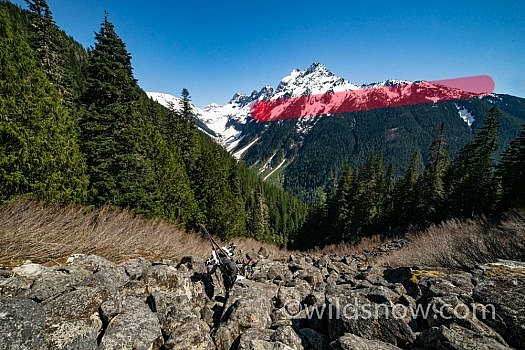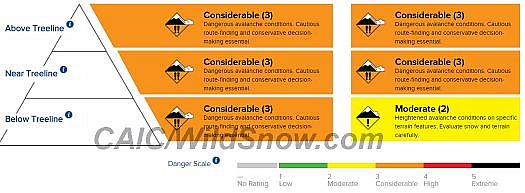This post sponsored by our publishing partner Cripple Creek Backcountry.
Warning: Basics ahead!
Some time ago, it was brought to my attention that the “terms of art” used regarding avalanche safety can exceed the understanding of those new to the game. For example: “treeline.” The experienced WildSnow reader might find it hard to imagine people don’t know exactly what “treeline” is, but such folks exist. They’re not unlike myself, when I go sailing once every decade and don’t know the difference between port and starboard. In that regard, a few terms for you newbies out there.

“Near treeline” highlighted, upper edge of the highlight would be roughly “treeline.” Sometimes the boundaries are much more defined, but this photo is representative of how rough and ill defined “treeline” usually is. Once you’re above treeline, in the “alpine,” it’s fairly obvious but you can still get confused if visibility is poor.
Treeline (AKA timberline): Regarding mountain topography, a roughly horizontal (though uneven) boundary formed by the elevation limit at which normal sized trees grow. In avalanche forecasts, you’ll hear phrases such as “danger above treeline.” More, many forecasts are formally divided between “above treeline, near treeline, below treeline.” Hence, you’d better know what “treeline” means and how to visually identify it when you’re on a ski tour.
Because “treeline” is not particularly defined, you’ll also hear the term “near treeline.” You can take that to mean the zone where there are trees, but their growth is still influenced by the altitude. “Near treeline” often consists of scattered, smaller trees interspersed with non vegetated areas. It varies in altitude by exposure and micro-climate. The way to think of it is “just below the obvious treeline, has trees, but they’re sporadic and often smaller than normal.” “Near treeline” is a narrow band, sometimes only a few hundred feet in elevation.

Typical avalanche forecast, this one from Colorado Avalanche Information Center. Note the division of forecasts by treeline. But, what is “treeline?”
Ratings: Forecasts are rated verbally as Low; Moderate; Considerable; High; Extreme. If that’s confusing, you only have other people to blame. Whoever chose to use poetry to rate danger should stick to, well, poetry. Meanwhile, here are the Cliff Notes from the poetry class:
Of all the ratings, “Low” means avalanches are the least likely to occur. The rub is that whenever there is snow, and slope angles, the possibility of avalanches exists. Thus, on a scale of 0 to 10, a “Low” is a 1 or 2. Not zero.
Next we have “Moderate,” which is actually the rating where most fatal avalanche accidents occur. Sort of like swimming with sharks and calling it a bit of moderate fun in the salt water sun. What Moderate actually means is that a natural occurring avalanche is unlikely to fall on top of you, but go ski an avalanche slope and there is a chance you could trigger your own personal snowslide. I’d call it numbers 3, 4, 5 on our 0 through 10 scale. Sometimes it’s a 3, which is pretty close to a 2…sometimes it’s a 5 and you could indeed easily kill yourself.
Considerable is levels 6 and 7. It means skiing certain exposures and elevations is nearly certain to trigger a slide. And one might fall on you as well. In terms of behavior, you can perhaps safely ski avalanche slopes during a “Considerable” rating, but only with careful evaluations and behaviors specific to each individual slope. Most backcountry skiers should simply stay off avalanche slopes during a “Considerable” rating. Most do (which is probably why so many accidents happen during “Moderate” periods).
Now the poetry gets boring. “High” is exactly what it says, level 8 through 9. Things are rocking and rolling whether you’re there or not. If you go, you’ll be like Indiana Jones running through the temple hall with stones falling at his heels. With one of those stones having your name on it.
The “Extreme” rating is reserved for special times. It’s level 10 and yeah, 11. During an “Extreme” cycle all sorts of slopes run naturally. It’s when you should even consider your highway driving plans, and how you’ll handle in-bounds “extreme” terrain where normally safe pockets could bury you. In a perfect world, “Extreme” rated days would only happen during NFL football games.
Now that you’ve seen our take, check out the official exposition of the North American danger scale.
Important note about all the above ratings: If you’re not ski touring in avalanche terrain, the ratings don’t matter. Thus, terrain identification is the first order of business if you’re learning about this stuff. There is a trend in the guidebook industry that’s intended to help. My “Uphill Skiing and Light Tours” book is an effort, and recent guidebook published in Norway “Avalanche Safe Tours in Norway,” is an impressive exposition of 150 routes in the country that invented modern skiing.
“Wind-loaded” is another term that confuses newcomers. It means the wind has moved snow onto a wind-loaded slope, thus possibly increasing the likelihood that slope will avalanche. It does not mean a slope with the wind blowing against it.
You’ll see the term “trigger,” as in: “you are likely to trigger an avalanche large enough to bury or kill you…” To some newbies it’s obvious what that means, in that by disturbing or weighting the snow on an avalanche slope, you start an avalanche, with you in it. But some folks don’t quite understand the importance of the term. It just means “start.” as in “you can trigger start an avalanche on northeast slopes steeper than 32 degrees. But the word “start” isn’t sexy, and it doesn’t imply the finality and direct action of “trigger.” Just remember that “triggering” an avalanche doesn’t require any sort of special NRA approved finger gestures or hopping from one ski to another in a certain rhythm. It simply means you, through your own presence on the snow, on an avalanche slope, can start an avalanche.
“Slab” is another potentially confusing term, but one with no better alternative. Snow tends to stick together rather than existing as a loose pile of particles. It thus forms “slabs” analogous to the layers of a bakery cake. These slab layers can be any thickness, from yards to inches, and form by a variety of means. Thus, you’ll see terms such as “storm slab,” meaning a slab created from new fallen snow. Or “wind slab,” meaning a slob formed from snow transported by the wind. There are old slabs, new slabs, deep slabs, hard slabs, soft slabs, even newlywed slabs (kidding on the last one.) Takeaway is when they mention any sort of “slab” in an avalanche forecast, it’s often in association with a dangerous condition. But not always.
Another confusing term is “step-down, e.g., “… if you trigger an avalanche in the new or wind-drifted snow it may step down to buried weak layers deeper in the snowpack…” Huh? What “step down” means is that an avalanche that begins as a slab near the surface of the snowpack carves away at the snowpack underneath itself as it slides, thus increasing in volume and ferocity. The resulting path of such a slide can resemble a series of steps, hence the term. Regarding hazards to your health, the possibility of “stepping down” means that a normally less dangerous slide can quickly become huge and likely to kill.
Any other terms you valued readers suggest we expose to the light?
Please also enjoy all our posts categorized as Ski Touring Basics. And remember to enroll in an avalanche safety course.
WildSnow.com publisher emeritus and founder Lou (Louis Dawson) has a 50+ years career in climbing, backcountry skiing and ski mountaineering. He was the first person in history to ski down all 54 Colorado 14,000-foot peaks, has authored numerous books about about backcountry skiing, and has skied from the summit of Denali in Alaska, North America’s highest mountain.
